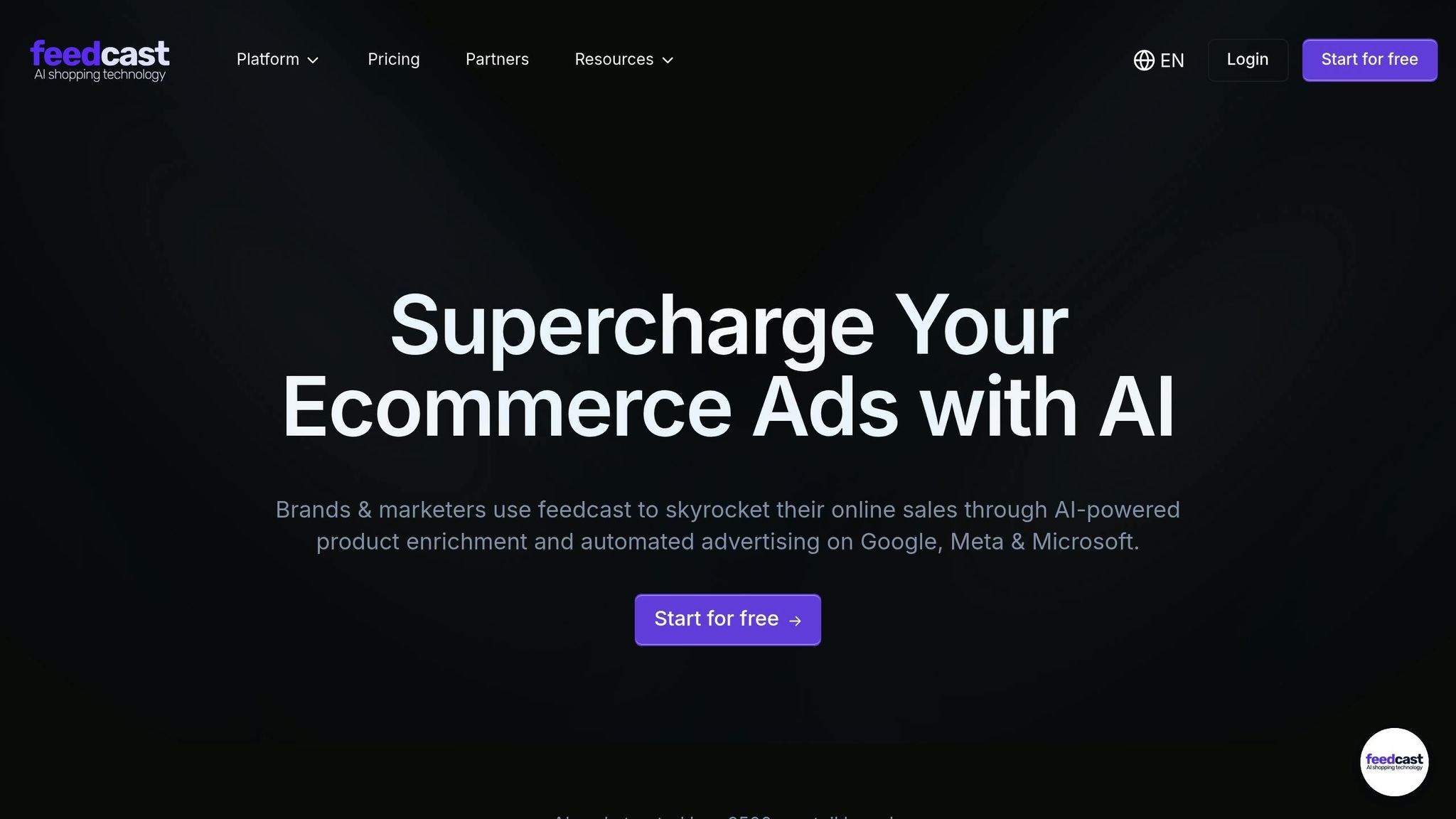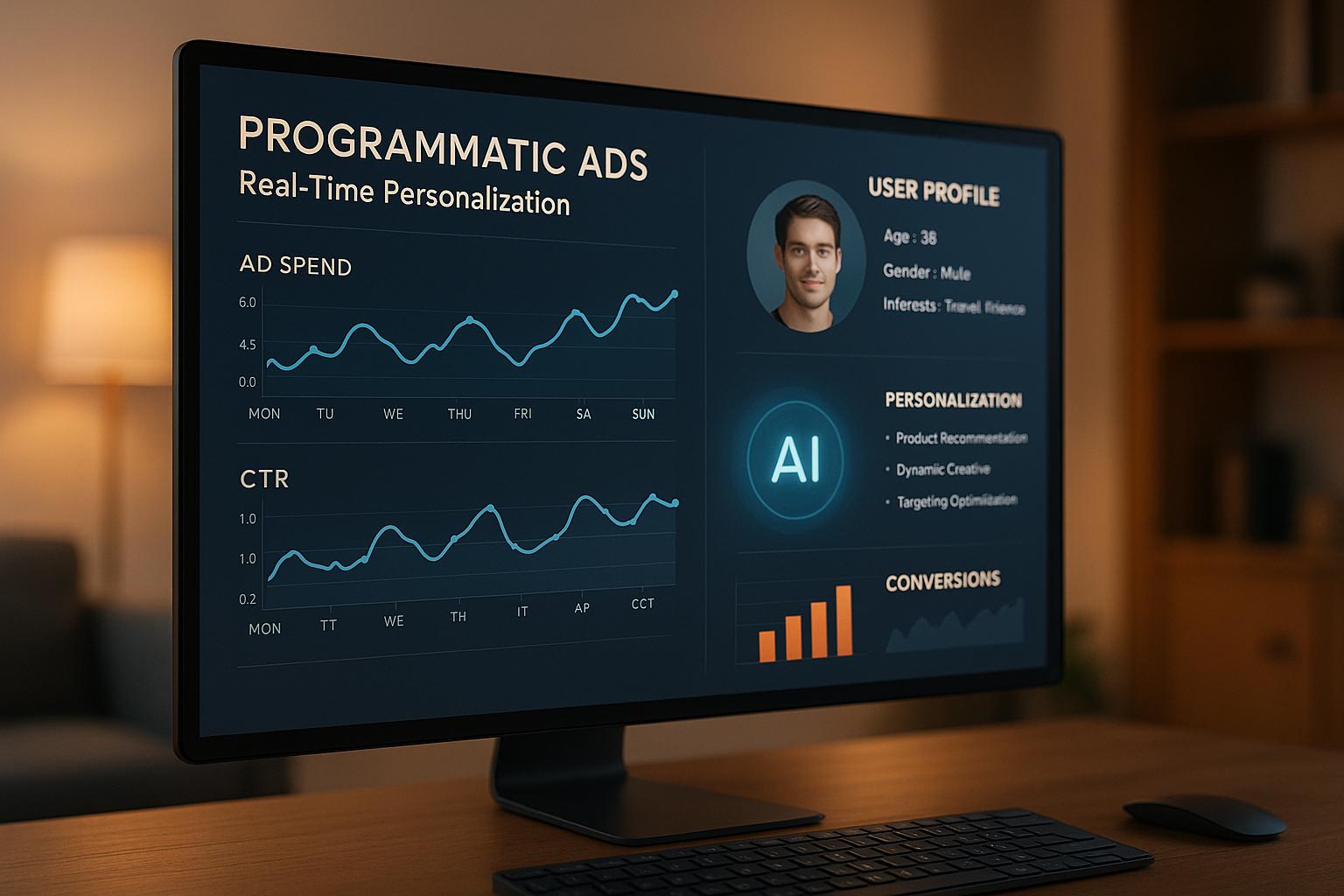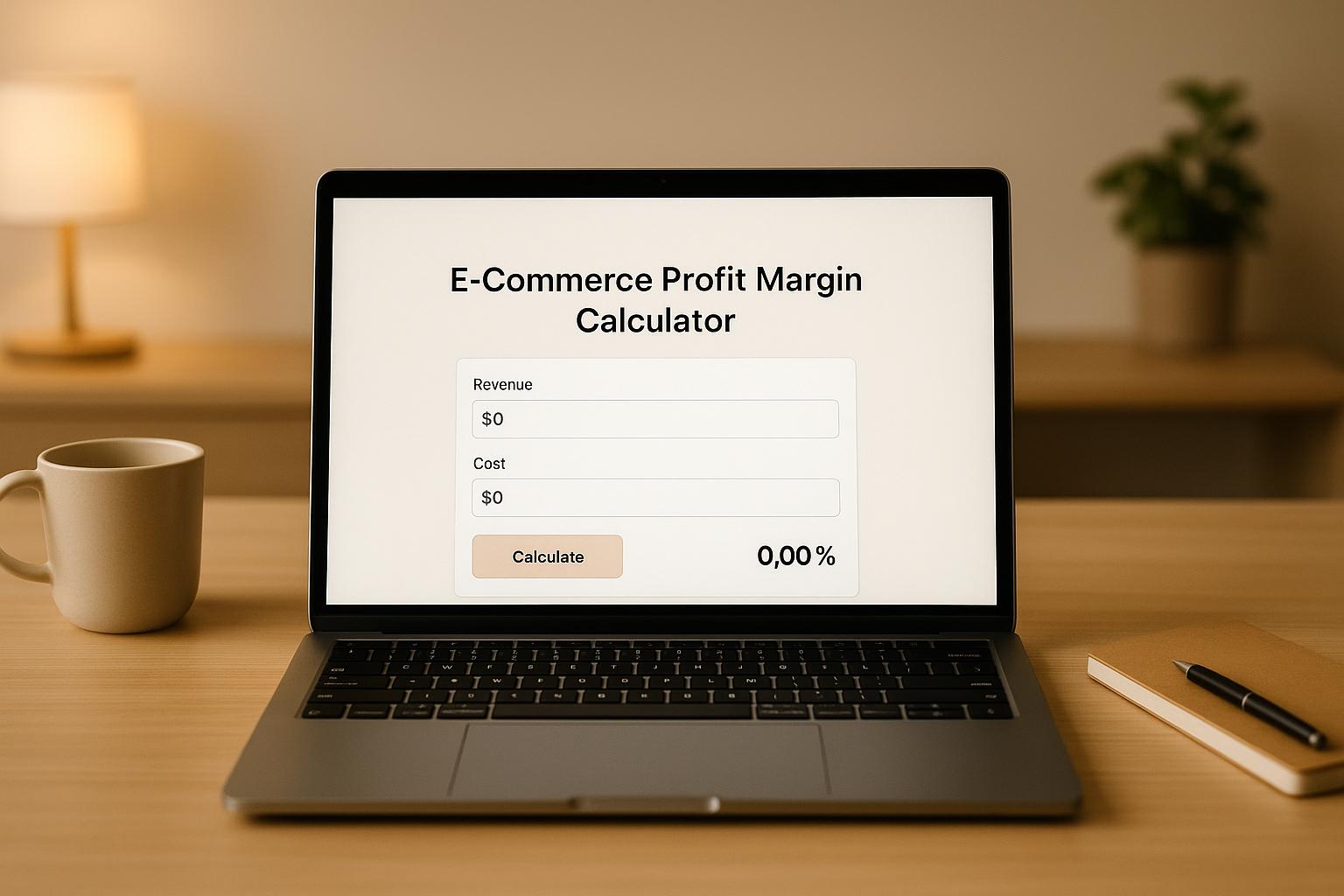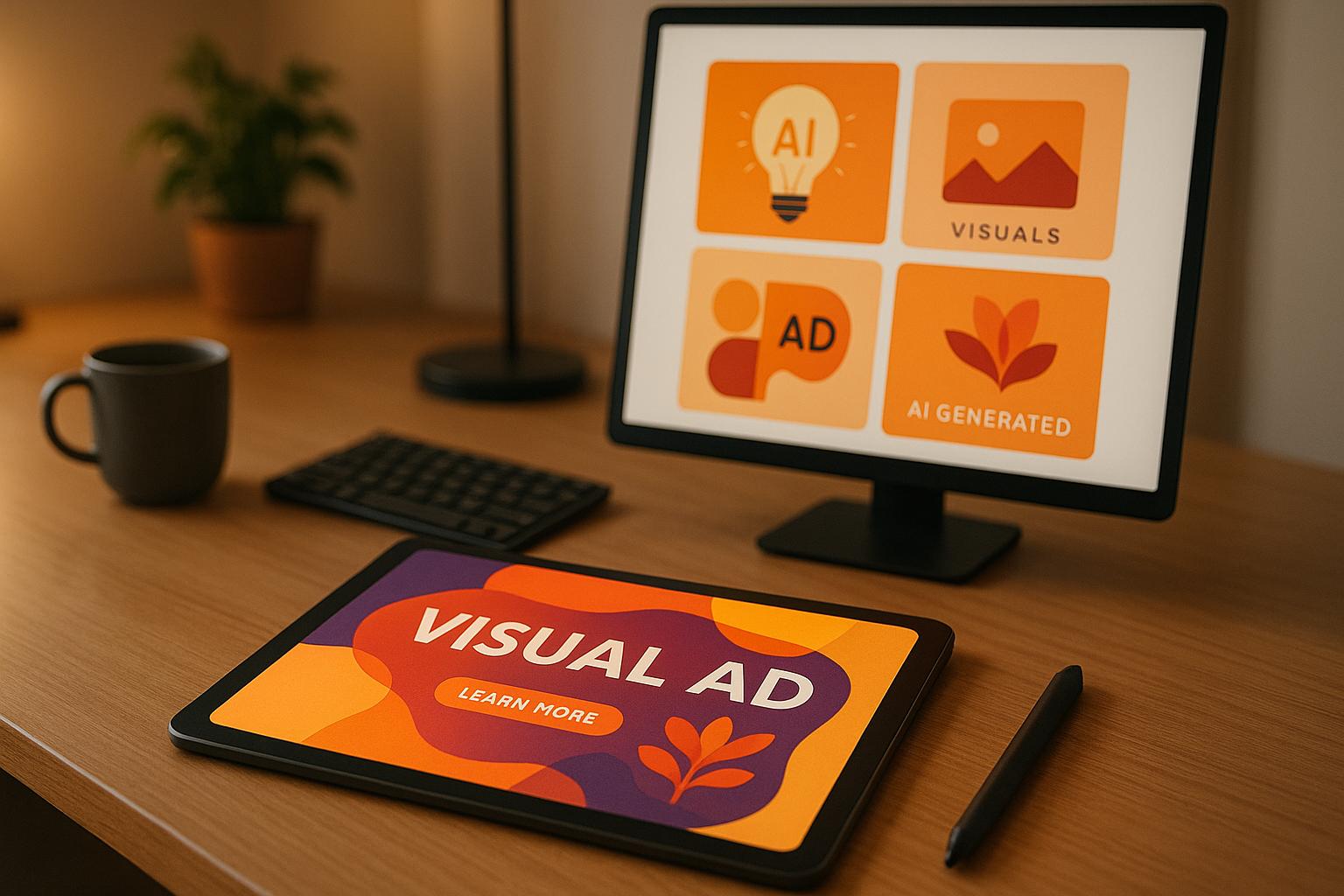How AI Enhances Behavioral Targeting in Ads
AI has transformed advertising by making it smarter, faster, and more precise. Behavioral targeting, powered by AI, uses real-time data like browsing habits, purchase history, and engagement patterns to deliver personalized ads that resonate with customers. Here's a quick breakdown of how this works:
- Real-Time Insights: AI tracks and predicts user behavior, ensuring ads are shown at the perfect moment.
- Dynamic Optimization: Campaigns adjust automatically based on performance, saving time and boosting results.
- Multi-Channel Integration: AI connects platforms like Google, Meta, and Microsoft Ads, creating a seamless ad experience.
- Cost Efficiency: Small businesses can now compete with larger ones by automating complex strategies without overspending.
- Privacy Compliance: AI respects laws like CCPA by using anonymized data and offering transparency.
With tools like Feedcast.ai, businesses can simplify ad management, enrich product data, and optimize campaigns across multiple platforms - all while focusing on what matters most: reaching the right audience effectively. AI is not just the future of advertising; it’s the present.
AI is Creating a Massive Shift in Facebook Ads Targeting is Good, Bad, & Ugly
How AI Analyzes Behavioral Data
AI takes massive amounts of behavioral data and turns it into actionable insights. Unlike traditional methods that leaned heavily on basic demographic details, AI dives deep into patterns of behavior to understand what customers want and when they want it. This in-depth analysis is the backbone of AI's approach to dynamic targeting and personalization.
Understanding Consumer Behavior with AI
AI doesn't just skim the surface - it examines multiple layers of consumer behavior. It tracks metrics like how long someone browses, the order in which they view content, and how they engage with it. This level of detail helps uncover a customer’s true interests and intent.
For example, by analyzing purchase history - including when, how often, and what triggers a purchase - AI can determine the best time to show an ad. If a customer tends to buy a specific product every month, AI can time ads perfectly to match that cycle.
Engagement metrics also play a big role. AI identifies which types of content resonate most with different audience segments, using this insight to fine-tune ad personalization.
Seasonal trends are another factor. AI analyzes how shopping behaviors shift depending on the day of the week or time of year. For instance, it might notice that customers are more active on weekends and adjust ad delivery accordingly.
Even device preferences come into play. AI can detect if customers research products on their phones but complete purchases on desktops - or if they prefer to do everything on their mobile devices. This allows businesses to optimize the ad experience for specific devices.
Real-Time Data Processing for Dynamic Targeting
One of AI's standout abilities is real-time data processing, which allows ad targeting to adapt instantly.
For instance, if a customer abandons their shopping cart, AI can immediately analyze the situation - looking at browsing history and past interactions - to craft a tailored retargeting strategy.
Unlike static audience categories, AI constantly updates customer profiles. A casual browser might suddenly shift into a "ready-to-purchase" category, and AI adjusts targeting on the fly to reflect this change.
AI also connects the dots across different platforms and devices. If a customer views a product on social media, researches it online, and later visits a retailer's website, AI links all these interactions into a single, cohesive behavioral profile.
Timing is another area where AI excels. It identifies when customers are most likely to engage and adjusts ad delivery accordingly. At the same time, it reduces exposure when signs of ad fatigue appear, ensuring a better overall experience.
Privacy Considerations and Compliance
AI-driven behavioral targeting must operate within the boundaries of U.S. privacy laws, such as the California Consumer Privacy Act (CCPA). These regulations require transparency in data collection and give consumers control over their personal information. While AI's dynamic targeting enhances ad effectiveness, it must also meet strict privacy standards.
To address these challenges, many AI systems now incorporate privacy-focused design principles. Techniques like data anonymization and aggregation allow behavioral analysis without storing identifiable personal information.
Clear communication is key to earning customer trust. Businesses must explain what data is being collected, how AI processes it, and provide easy opt-out options. Limiting data collection to only what's necessary for targeting - known as data minimization - helps reduce privacy risks while maintaining AI's effectiveness.
Emerging methods like federated learning offer another layer of protection. This approach enables AI to learn from collective behavioral patterns across organizations without sharing raw user data. Regular audits of AI systems further ensure compliance by monitoring data practices, storage policies, and the transparency of algorithmic decisions.
Balancing effective ad targeting with strong privacy protections not only ensures compliance with laws but also builds trust with customers. This trust is essential for creating lasting relationships and achieving long-term success in behavioral targeting.
AI-Powered Tools for Personalization and Optimization
AI is reshaping the way businesses approach advertising by enabling highly personalized interactions. By analyzing individual behaviors, AI creates tailored messages that align with each customer's unique preferences and needs.
Personalized Ad Content Creation
AI takes ad personalization to the next level by crafting content that matches a viewer's specific interests and shopping habits. It evaluates how customers engage with various types of content. For example, if someone responds better to ads showcasing product benefits rather than discounts, AI adjusts the messaging to reflect that preference.
It doesn’t stop there. Dynamic product recommendations are another powerful feature. AI examines purchase history, seasonal trends, and related products to suggest items that are relevant. For instance, a customer who buys running shoes might later encounter ads for moisture-wicking socks or fitness trackers, timed perfectly to their shopping habits.
Timing and frequency are also key. AI identifies when customers are most likely to engage with ads and schedules delivery accordingly. It also monitors engagement levels to avoid overexposure, ensuring that ads remain effective without causing fatigue.
Building on these personalized strategies, AI takes optimization to another level with real-time targeting enhancements.
Optimization with Smart Targeting
AI’s smart targeting capabilities identify high-value audiences and fine-tune ad delivery in real time, boosting engagement and conversion rates.
One standout feature is the creation of lookalike audiences. By analyzing the traits and behaviors of existing customers, AI pinpoints new prospects who share similar characteristics. Unlike traditional methods, these audiences are continuously updated as new data reveals what drives successful conversions.
Retargeting strategies also benefit from AI’s precision. It segments visitors based on their actions - someone browsing multiple items might see different messaging than someone who abandoned a specific product in their cart. AI even determines the ideal number of interactions needed to convert each type of customer.
Cross-channel optimization ensures that messaging stays consistent while adapting to the strengths of each platform. For example, AI might showcase a detailed product demo on Facebook, send a quick reminder on Instagram, and deliver a discount offer through Google Ads - all working together to guide the customer through their buying journey.
AI also excels at budget allocation. It dynamically shifts ad spending to the most effective audiences and channels, making adjustments throughout the day based on real-time performance. This eliminates guesswork and ensures every advertising dollar is spent wisely.
Feedcast.ai's Role in Improving Ad Campaigns

Feedcast.ai integrates these advanced personalization and targeting features, making campaign management easier for e-commerce businesses. It simplifies technical processes and provides tools that help businesses run more effective campaigns.
One highlight is product data enrichment, where AI enhances product titles, descriptions, and attributes. This makes items more discoverable and boosts the quality of ads across various platforms.
With its unified dashboard, Feedcast.ai connects accounts from Google, Meta (Facebook and Instagram), and Microsoft Ads. This centralized interface allows businesses to manage behavioral targeting campaigns seamlessly.
Through AI-powered ad creation, the platform generates personalized copy tailored to different channels and audience segments. By analyzing product information, customer behavior, and platform requirements, Feedcast.ai produces ads that resonate with specific audiences - saving time and improving overall performance.
Its smart targeting features help businesses effectively reach both new and returning customers. By analyzing customer data, Feedcast.ai identifies the best audience for each product and optimizes ad delivery to increase engagement and conversions. The platform continuously learns from campaign results, refining its recommendations over time.
Finally, multi-channel campaign management ensures that targeting strategies are consistent across all platforms. Feedcast.ai synchronizes product feeds, keeps inventory information up to date, and coordinates messaging to provide a seamless customer experience regardless of where the ads appear.
To top it off, Feedcast.ai offers detailed performance analytics, giving businesses insights into how campaigns perform across channels and customer segments. This data helps pinpoint the most effective personalization strategies, guiding future optimization efforts for maximum return on investment (ROI).
sbb-itb-0bd1697
Benefits of Unified Multi-Channel Advertising with AI
Managing ads across multiple platforms can feel like juggling too many balls at once - constantly switching dashboards and manually reconciling data. AI-powered unified platforms simplify this process by bringing everything under one roof and automating much of the heavy lifting.
Centralizing Ad Account Management
One of the biggest advantages is the ability to manage everything from a single dashboard. Instead of bouncing between Google Ads, Meta Business Manager, and Microsoft Advertising, marketers can oversee all their campaigns in one place. This alone saves hours of time each week by cutting out repetitive administrative tasks.
AI takes it a step further by automating routine processes. It can automatically import product feeds, streamline ad creation, and instantly flag issues like feed errors or out-of-stock items. This reduces the need for constant manual intervention.
Budget management also becomes more effective when centralized. AI can dynamically reallocate funds, shifting spending from underperforming campaigns to those delivering better results. For example, platforms like Feedcast.ai integrate Google, Meta, and Microsoft Ads, syncing product data to ensure consistent inventory and pricing across channels.
This centralized approach not only saves time but also sets the stage for deeper insights across all advertising efforts.
Cross-Channel Analytics for Targeting Insights
Centralizing ad management opens the door to unified analytics, where data from all channels comes together to create a clearer picture of your audience. When you combine insights from multiple platforms, you start to see patterns that wouldn’t be obvious otherwise. For instance, AI might reveal that customers who click on Instagram ads but don’t convert are more likely to make a purchase after engaging with complementary ads on search or display networks.
Aggregating real-time behavioral data makes targeting even smarter. AI can figure out the best timing, messaging, and channel for follow-up interactions by analyzing these combined signals.
Unified analytics also allow for more precise audience segmentation. For example, someone engaging with video content on one platform and responding to a different ad format on another can be targeted with tailored messaging across all channels.
When AI examines complete customer journeys, it can predict which new prospects are most likely to convert based on patterns observed across platforms. This predictive capability helps refine targeting strategies and improve overall campaign performance.
Improving Campaign Efficiency and ROI
Once unified management and analytics are in place, AI can further optimize campaigns to boost efficiency and ROI. It adjusts bids, budgets, and targeting in real time across all platforms. For example, if a shopping campaign starts outperforming a social media campaign for a specific product, the system can automatically shift budget to capitalize on the trend.
This approach also reduces wasted spending by coordinating messaging across channels. Instead of blasting the same promotional message everywhere, AI ensures that ads guide prospects through a logical sequence - from awareness on social media to consideration via search ads, and finally, conversion through retargeting.
As AI handles the complexity of managing multiple channels, scalability becomes much easier. Businesses can expand their advertising reach without significantly increasing the workload, freeing marketing teams to focus on strategy instead of execution.
Amazon showcases the power of unified, AI-driven advertising through its recommendation engine, which accounts for 35% of its total revenue. Customers engaging with personalized recommendations spend 29% more per session and have a 73% higher lifetime value compared to those who don’t interact with these AI-powered suggestions[1].
Connected TV ad spending is predicted to hit $42.5 billion by 2028, while the retail media sector is on track to exceed $100 billion in value[2].
Unified analytics also make performance tracking more meaningful. Instead of trying to compare inconsistent metrics from different platforms, marketers get standardized, comparable data. This clarity makes it easier to identify which strategies are working, empowering quicker decisions and smarter budget allocation. By leveraging these insights, businesses can maximize ROI and deliver more precise, behavior-driven advertising campaigns.
Best Practices for Implementing AI-Based Behavioral Targeting
To make AI behavioral targeting work effectively, you need clean data, smart automation, and a commitment to fine-tuning your strategies.
Streamlining Product Data Management
Your product data is the backbone of successful behavioral targeting. If your data is messy or incomplete, you'll end up with mismatched ads and wasted ad spend. On the other hand, accurate and enriched product information allows AI systems to make smarter decisions about who to target.
Start by centralizing your product feeds. Whether you're pulling inventory from platforms like Shopify or WooCommerce, or uploading CSV files, having all your data in one place makes it easier to manage. Tools like Feedcast.ai can pull product information from multiple sources, saving you from tedious manual updates.
AI can also enhance your product data by enriching it with optimized details. For instance, instead of a generic title like "Blue Shirt Medium", AI can generate descriptions that emphasize features customers care about. This improved data helps AI algorithms better match products to specific customer segments.
Another advantage of AI tools is their ability to spot and fix feed errors, such as missing prices or broken links. This prevents wasted ad spend and keeps your product data synchronized across platforms like Google Shopping, Facebook catalogs, and Microsoft Merchant Center. When inventory levels or prices change, these updates are reflected instantly, ensuring your ads stay accurate.
Once your data is clean and optimized, you’re ready to move on to automating targeted campaigns.
Setting Up Automated, Targeted Campaigns
With organized product data in place, AI can take over the heavy lifting of creating targeted campaigns. The trick is to let AI learn from customer behavior while still maintaining control over your brand's messaging.
AI can segment your audience by analyzing browsing habits, purchase history, and engagement data, creating tailored campaigns for each group. To ensure consistency, provide the AI with clear brand guidelines and messaging templates. This way, the content remains aligned with your brand while still being personalized for individual customer segments.
Dynamic retargeting is another powerful tool. AI adjusts messaging, timing, and frequency in real time based on how customers interact with your ads. For example, someone who abandoned their cart might see a discount offer, while a first-time visitor might get an introductory message.
To maximize impact, ensure your campaigns are coordinated across multiple channels. AI can help create a seamless experience, guiding customers from awareness to consideration to conversion, no matter where they interact with your brand.
Monitoring and Iterating for Success
Clean data and targeted campaigns are just the beginning. To stay competitive, you need to monitor performance continuously and make adjustments as needed. In fact, 88% of marketers believe increasing the use of AI and automation is crucial for staying ahead [3].
Keep an eye on metrics like conversion rates, engagement levels, and return on ad spend (ROAS). AI-powered dashboards can alert you to significant changes in these metrics, giving you insights into what’s working and what needs improvement.
Marketers using AI report tangible benefits - 45% see improved workflow efficiency, and 42% notice better content optimization [4]. Use behavioral insights to test and refine your strategies, whether it’s tweaking ad bids, adjusting schedules, or fine-tuning your messaging.
Predictive analytics can also give you an edge by identifying trends before they fully emerge. For example, if certain customer segments start responding less to a particular message, AI can flag this early, allowing you to pivot your approach proactively.
Finally, consolidate your data into unified reports that capture the entire customer journey. When you combine behavioral targeting data from platforms like Google, Meta, and Microsoft into a single dashboard, it’s easier to see which channels and messages deliver the best results. This holistic view helps you allocate your budget more effectively and ensures your campaigns are well-coordinated.
With 19.2% of marketers dedicating over 40% of their budget to AI-driven campaigns, the stakes are high [3]. Regular performance reviews should not only identify what’s working but also dig into why certain strategies succeed. This insight allows you to scale successful approaches while cutting out what doesn’t work, ensuring your campaigns continue to improve over time.
Conclusion: The Future of AI in Behavioral Targeting
AI has transformed behavioral targeting by taking over complex, time-consuming processes and delivering faster, more efficient results.
Key Takeaways
AI processes data in real time to deliver personalized ads, while automating bid and targeting adjustments to make the most of your advertising budget. Its ability to analyze data as it happens ensures precise targeting that aligns with individual customer behaviors in the moment.
It also connects multi-channel campaigns seamlessly, creating a unified customer experience. Whether on Google, Meta, or Microsoft platforms, AI can guide potential customers through every stage of their journey - from first discovering your brand to making a purchase.
Perhaps most importantly, AI has leveled the playing field. Small and medium-sized businesses now have access to advanced targeting and optimization tools that were once only available to large corporations with big budgets and dedicated marketing teams.
These capabilities are just the beginning, as new trends continue to shape the future of AI-driven advertising.
Emerging Trends in AI-Powered Advertising
Predictive customer lifetime value modeling is advancing, enabling businesses to identify high-value prospects even before their first purchase. This helps allocate budgets more strategically, focusing on customers likely to bring in the most long-term revenue.
Cross-device behavioral tracking is improving, connecting interactions across smartphones, tablets, and desktops. This creates a more complete view of the customer journey, making retargeting efforts more effective.
AI is now optimizing voice and visual searches, reflecting how consumer behavior is evolving. Businesses that adapt to these intuitive search methods early will gain a competitive edge as these trends grow.
Real-time inventory-based targeting is becoming more refined. AI can automatically adjust ad spend and targeting based on stock levels, seasonal trends, and demand. This ensures you’re not wasting money advertising out-of-stock items while maximizing visibility for products that are ready to ship.
Call to Action for E-commerce Businesses
E-commerce businesses need to adopt AI-powered behavioral targeting now to stay competitive. The technology has reached a point where implementation is straightforward, and even smaller teams can manage the learning curve.
Start with clean, well-organized product data and integrate your ad accounts using platforms like Feedcast.ai. This tool simplifies product data management and campaign integration, laying the groundwork for effective AI targeting. You can ease into it by maintaining your current campaigns while gradually incorporating AI-driven features.
Consistent measurement and iteration are key. The businesses that thrive with AI behavioral targeting are those that regularly analyze performance data and refine their strategies. Set up automated reporting to track key metrics across all advertising channels, and schedule regular reviews to identify areas for improvement.
The future of e-commerce advertising belongs to businesses that blend human creativity with AI’s efficiency. By starting with strong data management and gradually expanding your use of AI tools, you’ll build a competitive edge that only grows stronger over time.
FAQs
How does AI improve behavioral targeting while ensuring privacy compliance?
AI is transforming behavioral targeting with privacy-conscious methods such as contextual targeting. Instead of relying on personal user data, this approach tailors ads based on the content of the webpage a user is viewing. The result? Ads stay relevant without compromising user privacy.
On top of that, AI supports businesses in meeting privacy regulations by promoting transparent data practices. This includes obtaining clear user consent and limiting data collection to only what's absolutely necessary for ad targeting. These strategies allow businesses to craft personalized campaigns that align with modern privacy standards.
How can businesses start using AI to improve behavioral targeting in their ad campaigns?
To dive into AI-driven behavioral targeting, businesses should start by pinpointing their ideal audience. This involves examining customer data, including browsing patterns, purchase records, and individual preferences. Once this foundation is set, AI tools can step in to group customers into distinct segments and craft ad content specifically designed for each group.
Platforms offering AI-powered targeting features, such as automated audience segmentation and real-time campaign adjustments, make it easier to deliver ads that resonate with the right audience. On top of that, integrating AI analytics allows businesses to track performance closely and tweak their strategies as needed, ensuring campaigns stay engaging and in tune with customer behaviors.
How does AI optimize ad delivery across different platforms in real time?
AI takes ad delivery to the next level by analyzing real-time performance data and making instant adjustments to crucial components like targeting, bidding strategies, and ad creatives. This ensures ads are perfectly aligned with audience behavior and the specific demands of each platform, boosting their relevance and engagement.
Through dynamic campaign management and automated decision-making, AI keeps refining campaigns on the fly. It delivers the right message to the right audience at the right moment, helping businesses achieve stronger results while cutting down on time and effort.
Geoffrey G.




